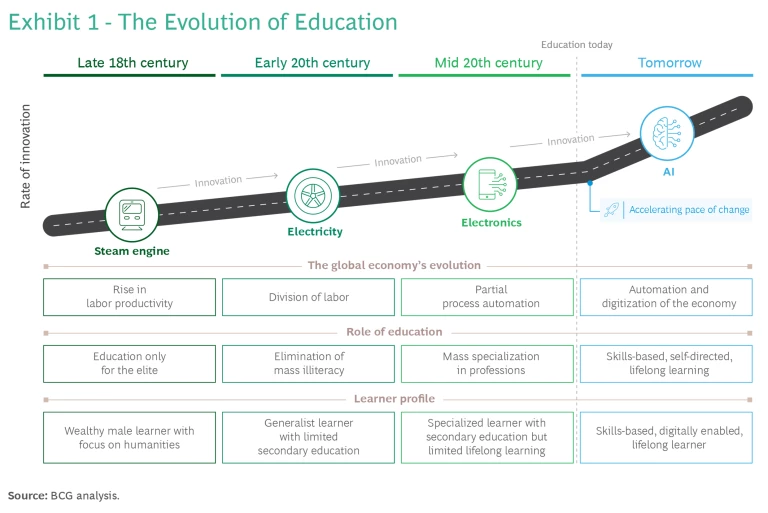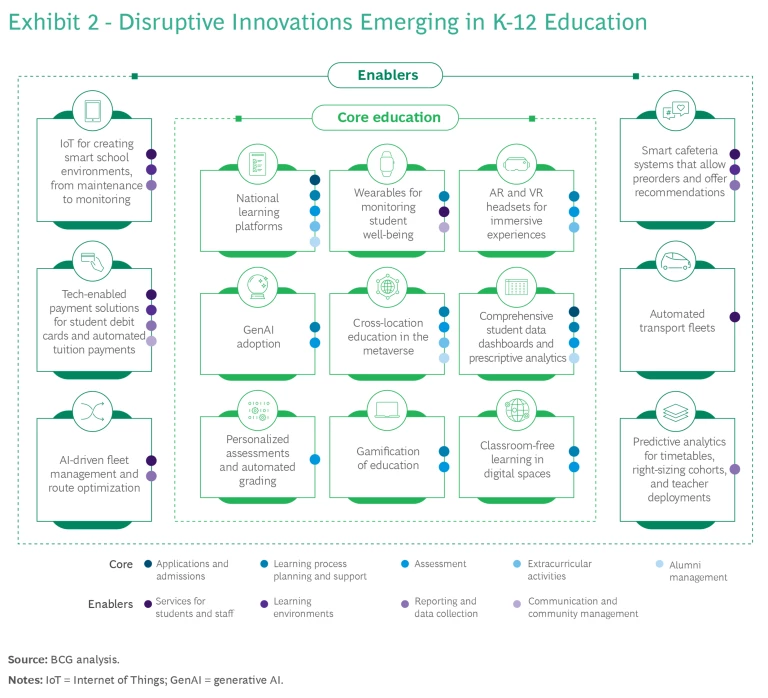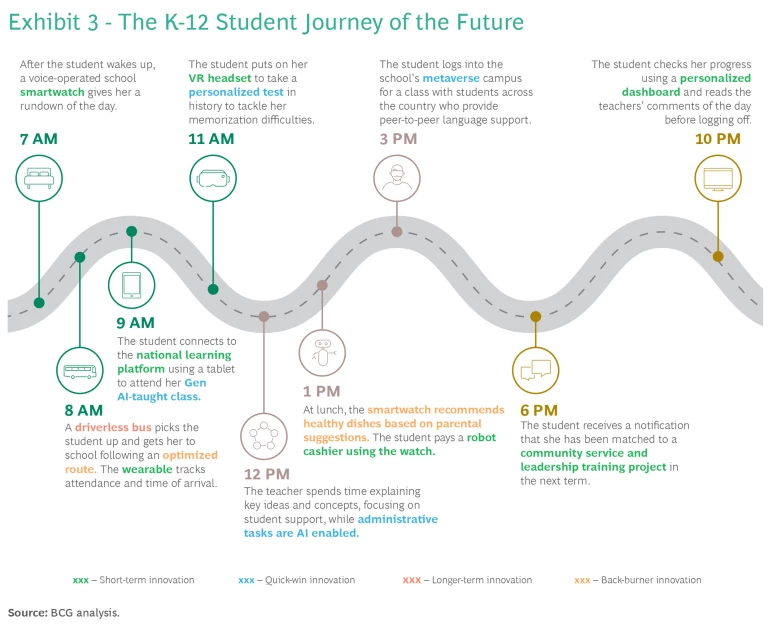If education is to remain relevant, it has to change as dynamically as the new world for which it prepares people. As someone famous famously said, “We cannot solve our problems with the same thinking that we used when we created them.” To inculcate fresh thinking, our studies show that education—especially K-12 education —must embrace disruptive innovation as its guiding principle.
To be sure, education has evolved in recent times, particularly in the COVID-19 pandemic’s aftermath and AI’s rise. Students have gained access to online resources, interactive learning platforms, and educational apps, while the use of digital tools, such as smart boards, tablets, and learning management systems, has shot up. Some schools are also experimenting with new teaching methods such as flipped classrooms (in which “classroom” lectures are viewed at home and “homework” is done at school) and project-based learning, to foster problem-solving skills, creativity, and collaboration.
However, progress has been slow at best. Most innovations have been additive and evolutionary rather than disruptive and revolutionary. Several have been isolated experiments rather than systemwide shifts, minimizing their impact. Change has been impeded in particular by the complex economic, social, and political environment in which those in education must function. (See Exhibit 1.) It often appears that education is subject to Eroom’s law, which posits that in some sectors, improvement only becomes slower and more expensive over time.

Meanwhile, the nature and needs of K-12 students have changed radically and rapidly. Every K-12 student today is a digital native, and because of the rise of digital technologies—especially AI—the future of work will be different from its past. Only through disruptive innovation will schools stop lagging change and be able to rapidly equip today’s learners with the skills and knowledge they will need to tackle tomorrow.
Only through disruptive innovation will schools be able to rapidly equip today’s learners with the skills and knowledge they will need to tackle tomorrow.
Education’s stakeholders—governments, companies, and schools—must collaborate to develop a new genre of innovations that can be deployed at scale to produce breakout learning outcomes. So how can K-12 education break out of the classroom?
Rather than hunting for innovations that may improve K-12 systems, educators should look at other industries to learn how they have successfully transformed and identify the tools they have used. Several other sectors have brought about change quickly by adopting disruptive innovations, setting trends rather than reacting to change. Our research, combined with our experience in working with educators and policymakers, shines a spotlight on the most promising principles that K-12 education can follow to develop and deploy disruptive innovation.
Drawing Disruptive Parallels
To figure out the foundational principles of disruptive innovation, we conducted an in-depth analysis of 16 industries. These ranged from traditional sectors (such as automotive, chemicals, construction and building, and metals and mining) to mature ones (such as aerospace and defense, consumer goods, energy, and utilities) to relatively newer ones (such as financial services, health care, and telecom, media, and technology).
Our research helped identify six sectors—health care; transportation and logistics; food and agriculture; financial services; telecom, media, and technology; and entertainment, leisure, and sports—that could inspire disruptive innovation in education. Not only did the quest for innovation start much earlier in those sectors than it has in education, but that undertaking has also resulted in disruptive innovations that have rapidly transformed these industries.
Conducting deep dives into those six sectors led to the development of an approach for developing disruptive innovations in education. In parallel, we created a framework consisting of five enablers and four core elements to study K-12 education systems and traced the main stakeholders that would need to work together to deploy innovations at scale.
A Framework for Reshaping Education’s Future
By integrating six elements into the educational experience, stakeholders can foster innovations that will disrupt the K-12 system. Tomorrow’s education must be personalized, experiential, adaptable, scalable, inclusive, and sustainable.
Personalized. In the future, K-12 education must be tailored to individual needs, so students can embark on personalized journeys. Educators must use digital technologies and tools to go beyond standard assessments and offer learner-driven, competency-based experiences.
Experiential. Students benefit immensely from interdisciplinary learning experiences that are focused on real-world problem solving. Educators should therefore prioritize hands-on projects and collaborative tasks that equip students with practical skills for navigating complex challenges.
Adaptable. Education systems must be flexible, integrating technological advancements and aligning with evolving workforce needs. Educators can prepare students for success in a fast-paced, dynamic world by embracing change themselves.
Scalable. Technology-driven solutions will expand access to education so that it’s able to reach large groups of learners across ages. These systems must be designed inclusively, so that they serve all ages and backgrounds equitably.
Inclusive. Schools must foster inclusive environments, embracing diversity across socioeconomic, cultural, and even educational backgrounds, be they learners with disabilities or those considered gifted.
Sustainable. K-12 education should instill environmental awareness in students, promoting sustainable practices in learning activities and institutional practices.
Identifying Innovations for Next-Gen Education
Applying this framework helped us identify some key innovations that will affect both the core elements as well as the enablers of education systems, transforming the K-12 student’s education journey. (See Exhibit 2.) These innovations are best understood in the context of the three stages of the student journey: before school, during school, and after school.

Before School. Even before students enter the portals of learning, schools can use different types of wearables, such as fitness trackers, rings, and cards, to track their health and stress levels as well as to provide alerts and reminders for promoting healthier habits. Automated transport fleets will prioritize safety and efficiency on campuses, while AI-driven fleet maintenance and route optimization will ensure safe and efficient transportation to centers of learning.
During School. A national learning platform will offer a number of educational resources, such as remote learning functionality, digital content, assessments, and teacher training materials. The use of generative AI (GenAI) is also likely to become widespread in schools, generating personalized content, providing students with tailored feedback on assignments, and fostering creativity. It may well revolutionize learning by helping educators develop new teaching methods based on the technology. Moreover, by building these tools themselves, schools will ensure the best use of GenAI for education.
In addition to physical campuses, schools may want to develop metaverse-enabled education modules. Creating virtual shared spaces for global collaboration and learning will allow students from different locations to attend virtual lectures and engage in cross-border projects. In addition, classroom-free learning in digital spaces, metaworlds, and outdoor areas will allow schools to embrace a flexible approach. This kind of innovation offers opportunities for independent, self-paced, and creative learning through new environments such as venturing outside the classroom, education expeditions, and virtual learning worlds.
Using the cornerstones of gaming, such as points, rewards, and competitions, offers an interactive and motivating way for students to grasp complex concepts. For immersive experiences, a new generation of AR and VR hardware, like Apple’s Vision Pro, will allow students to virtually explore historical landmarks, conduct hands-on experiments, and so on. Personalized assessments, adapted to each student, will enhance individuals’ understanding of subjects and enable prompt feedback. Automated grading tools will speed up the assessment process, reducing educators’ workloads and promoting quicker learning.
Digital payment solutions, such as student debit cards and automated tuition payments, will streamline financial transactions. They offer both convenience and efficiency, making it easier for students and parents to manage school expenses. And smart cafeteria systems will allow pre-ordering and offer customized dietary recommendations.
After School. Powered by AI and analytics, student data dashboards and prescriptive analytics will provide schools with real-time insights into their students’ performances and offer personalized recommendations for interventions. This will allow educators to make data-driven decisions and ensure that they are meeting each student’s unique learning needs.
The disruptive enablers will include the Internet of Things (IoT), which will supply connectivity and intelligence for school maintenance and security. From monitoring temperatures and security to optimizing energy usage, IoT will help foster efficient and comfortable learning environments. Using predictive resource analysis systems, educators will be able to forecast their resource needs, such as staffing and textbooks, based on past data and analytics, and sustain the quality of the education they offer over time.
Educators will have to prioritize the development and deployment of these innovations to bring about speedy and systemic change at scale while coping with resource constraints. Determining which innovations to use will require educators to evaluate the impact and feasibility of each one. (See the sidebar “How to Prioritize Innovations for K-12 Education.” ) Used together, these innovations will create a student journey that is based on cutting-edge educational innovations. (See Exhibit 3.)

How to Prioritize Innovations for K-12 Education
Impact
What impact is the innovation likely to have on the student’s learning experience and outcomes? Thinking about this can help educators determine which innovations will optimize learning and educational experiences.
What will the effect be on resources, as measured by the cost savings as a result of the innovation? Asking this question can help educators determine which innovations are likely to improve efficiency by reducing costs, shrinking manpower, or increasing resource utilization.
Feasibility
What are the financial and human capital requirements for the successful deployment of the innovation? Estimating both will help educators understand the resources required so that the innovation’s rollout becomes easier.
Is the innovation scalable across K-12 systems? Understanding this will help determine whether the innovation can only be deployed in elite institutions or it can be used on a regional, national, and even global scale.
What will be the lead time to build and deploy the innovation at scale? Gauging this will help educators classify innovations by time frame—short, medium, or long term—they will take to make an impact.
A Call to Action
To create an environment that allows the most promising disruptive innovations to flourish, the three institutional stakeholders in education—governments, companies, and schools—have distinct roles to play.
Governments. Governments must provide schools with access to digital technologies and connectivity so that schools can benefit from digital innovations. Local, regional, and national governments can foster innovation by doing three things. First, they can draft and implement new laws and regulations for the digital age. Second, they can offer financial and non-financial incentives for business to engage with the education sector. And third, they can provide subsidies for schools that are the first to adopt disruptive innovations such as GenAI.
Policymakers have to create national platforms—which are essential to promoting equitable access to quality education—and establish standard requirements to ensure consistency and accountability. At the same time, regulatory frameworks should be as flexible as possible to allow for experimentation and the adoption of innovative methods and technologies. Streamlining the accreditation processes for nontraditional models will encourage their development. Wise governments will create pilot programs in sandboxes, which will allow schools to test radically new ideas without fear of the fallout.
Financial support by governments for teacher training in new technologies and pedagogical approaches will be essential to drive change at scale. Linking funding to the use of innovative practices, in addition to educational outcomes, will motivate educational institutions to adopt cutting-edge methods. For instance, Finland—a global leader in delivering educational outcomes—is known for its emphasis on teacher autonomy, experiential learning, and a reduced focus on standardized testing.
R&D grants, subsidies, and tax breaks for companies that invest in educational technology and content development will draw the private sector to education. The public-private partnerships that follow will create mutually beneficial relationships, bringing employer expertise and resources into education systems. Several states in the US, such as California and New York, have recently created pilot programs for new teaching methods and competency-based learning and partnered with technology giants to integrate digital tools into classrooms.
Governments should encourage companies to participate in mentorship programs and provide students with exposure to business. That will strengthen the link between education programs and business needs, prepare students for future careers, and prevent degree inflation. Since 2007, Singapore has been showing the way by investing in initiatives such as the FutureSchools@Singapore program, which pushes the use of digital technologies for personalized learning and skills development. By constantly investing in and innovating the program, the city-state ensures that it produces the kind of talent it needs to keep growing.
Companies will have to play an unfamiliar but pivotal role in making K-12 education more relevant by helping to scale disruptive innovations.
Business. Companies will have to play an unfamiliar but pivotal role in making K-12 education more relevant by helping to scale disruptive innovations. To drive the process, investing in education research and creating cutting-edge educational technologies and tools will be essential.
Collaborating with educators will ensure that businesses develop innovations that align with educators’ goals and methods. Companies must focus on creating scalable technologies that can be adopted by schools in any kind of educational system. That will require designing cost-effective solutions, providing teacher training programs, and ensuring compatibility with the existing education infrastructure.
Furthermore, companies can establish partnerships with educational institutions to pilot and refine new offerings. A collaborative approach will allow companies to gain insights into the specific challenges that schools face, and that will ensure that their solutions are tailored to those needs. Their objective must be to contribute fresh knowledge about learning and teaching that will help educators continuously innovate the K-12 student’s experience.
Companies should support the use of open platforms that will allow educators to learn from one another’s experiences. Sharing will foster a community-driven approach to disruptive innovation in education, creating an ecosystem in which best practices are exchanged, improved, and scaled.
Schools. Learning institutions can catalyze innovation by striking strategic partnerships with businesses, implementing digital technologies ethically, and developing robust teacher training programs. Creating innovation hubs and pilot programs in each school district will allow them to test new teaching methods and technologies in controlled environments. They must adopt the “fail fast and learn” approach that accelerates innovation in other sectors.
Partnering with tech companies will help co-create educational solutions, ensuring that innovations align with curriculum goals and classroom realities. Such collaborations will provide teachers with access to cutting-edge technologies and industry expertise, facilitating the development and implementation of innovations that make an impact.
Schools partnering with tech companies will help co-create educational solutions, ensuring that innovations align with curriculum goals and classroom realities.
Ethical considerations are crucial, with the prioritization of data privacy, cybersecurity, and equitable access to digital technologies for all students. Establishing guidelines for the adoption of digital tools will ensure that digital innovations enhance learning without compromising student well-being. These initiatives will also allow for experimentation, feedback, and refinement before widespread implementation.
Teacher preparation is critical for the successful use of disruptive innovations. Investments in professional development programs that equip educators with the skills to integrate technology into teaching methodologies are necessary, as is the need to overhaul them constantly. Only continuous training will enable teachers to navigate the fast-changing educational landscape and allow innovative practices to take root at scale.
Finally, our work shows that school leaders are pivotal in driving innovation in K-12 education. They can promote design thinking, where administrators and teachers collaborate to identify challenges, brainstorm solutions, and develop innovative ideas. By establishing innovation labs or spaces in schools, they allow teachers and students to experiment with new technologies, teaching methods, and project-based learning experiences as well as personalized learning initiatives that tailor instruction to the needs and interests of each student. Above all, principals and other leaders can create an environment where innovation flourishes and educators are encouraged to push the boundaries of what is possible in K-12 education.
A mindset that focuses on developing disruptive innovations, coupled with investments and collaboration by all the key stakeholders, will lead to the transformation of K-12 education as we know it. Only when that happens can education keep up with the current pace of change and nurture the learners of the future, even as it teaches other sectors how to stay ahead.












